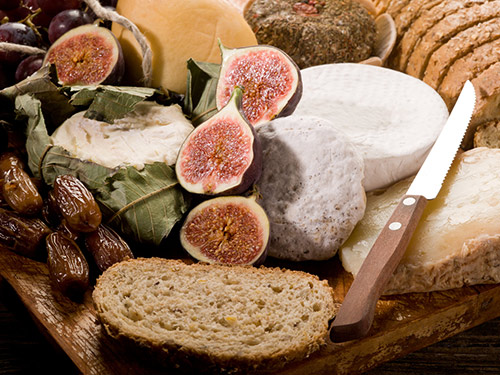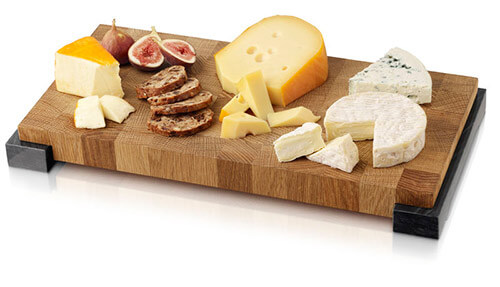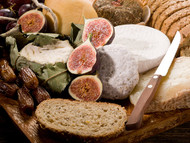What is the Best Cheese Board for a Cheese Snob?
Posted by Grant Chen on 13th Dec 2023

If visiting a cheese shop is a regular and normal occurrence in your week, then offering your curated delicacies on the best cheese board is a must. Picking the right cheese board can mean the difference between a ho-hum appetizer platter and a wow-factor party pleaser that guests won’t soon forget. That means not forgetting your finest Stiltons and Leicesters by letting them sit unattended on a simple wood platter. A real cheese flight deserves to be highlighted with all the right accouterments such as dried fruits, crackers, jams and served on a sturdy and properly chosen cheese board.
The Cheese Matters
Cheese comes in a myriad of flavors, shapes, consistencies and colors that traverse the world in their origin. Your cheese selection can be culled from one animal source (all goat, or all sheep’s milk), or can cross-represent different species. A well selected cheese board will narrate a story of it's own, solely based on the types of cheeses you proffer to your guests. A good host knows that unless you are throwing a gala for your local monger's club, a good board will showcase both soft and hard varieties and pungent and mild options, as to please all manner of palates.
But, we don't need to educate you more since you’re already a cheese snob, let’s get down to the business of selecting a proper serving board. There are several variables when deciding on a material, with only a few options standing up to the class and elegance of a fine ripened cheese selection. Below we explore some important points.
Wood Boards
The most common choice for serving cheese. Reliable, easy to clean and economical, a wooden cheese or serving board can be anything from a sectioned wood burl to an appropriated cutting board. What makes the real difference in the character of the wood and how it emphasizes the story of the cheese. For example, serving a wheel of casu marzu (a Sardinian sheep's cheese) on a rustic olive wood slab from Tuscany will evoke a true sense of exotic dining, whereas displaying this famous "worm's cheese" on a ratty cutting board with plastic spoons may turn your guests' stomachs. Presentation matters just as much as the provenance of said cheese.
In addition to aesthetics, a wooden cheese board makes for easy cutting of cheese. Rounds can be cut into wedges and harder cheeses like Parmesan or Pecorino can be brought down to reasonable blocks for your guests to shave and slice. Speaking of which, you do have a cheese knife set to go with your cheese board, right? Just incase your snobbery needs a reminder, here are the crucial must-haves:
- Spreader Knife: For soft cheese, made for putting on crackers or breads
- Cheese Plane: For hard and semi-firm cheeses, such as pecorino or parmesan. Doubles as server.
- Spade Knife: For hard cheeses
- Wide / Flat Knife / Server: For semi-hard cheese and to serve after slicing
- Fork: To serve cheese after cutting
Most knives serve two purposes, so it's possible to get by with two or one in a pinch, but like the cheese snob you are, you know that cutting and serving with the same utensils is certainly frowned upon. After all, you don't want your knife to turn into the Brie-Blue-Gruyere-Gouda mystery mobile that looks like a melted crayon.

When choosing a wooden cheese board, it's important to pick a species that will not absorb flavors easily. Cheese is by nature, rich in fats and oils, which have a propensity to go rancid once the fat oxidizes. While this is a part of natural aging process of cheese, most of the "pleasant" cheesey aroma is caused by the bacteria and yeast from the fermentation of the milk. Rancid fats create the same smell such as sour milk, which is sharp and generally unpleasant.
Woods to avoid that tend to pick up flavors are oak and most softwoods (fir, cedar, pine, larch, cypress). Oak in particular is famous for it's transference, as one look at a wine barrel and you'll immediately realize wine makers use oak because it easily absorbs and imparts flavors due to it's porous nature.
So when picking out a wood, a non-porous species is generally best to keep your wood from imparting any unwanted flavors. Some hardwoods that fall into this category include olive wood, birch, American cherry, hard maple and teak.
Porous woods include walnut and mahogony, so best to avoid these species. Do note though Brazilian walnut (Ipe), as seen in this paddle board, is not affected as Ipe is not a true walnut species.
If you must have one of the aforementioned woods ( larch for example, makes for a beautiful presentation), it is highly recommended to use both food safe oil and wax on a regular basis to season and seal in the wood to prevent imparting of flavors and smells.
Lastly, one careful point when picking out a cheese board is to ensure that it does not have any lacquer finish or varnish. Most of these finishes are not food safe and can chip when cut on, which will then make their way into your food.
Stone and Marble Boards
Stone boards, made from marble, granite or natural stone make excellent cheese presentation platters due to both their form and function. A marble board, in particular, offers a beautiful and cool surface on which to store cheese and will not absorb smells as easily as wood, though marble is still porous and requires care.
Marble or stone cheese boards will provide the best temperature zone for your cheese platter. These are dense materials and retain a large amount of thermal mass for their size. In English, this means that they are able to absorb heat faster than other materials and will transfer that heat away from your cheese, helping them to keep cool and not melt. For this reason, pastry chefs and candy makers overwhelmingly use marble in their professions, as it prevents dough from sticking and will set the chocolate faster and more evenly.
Thus, if you're planning on an outdoor event or your cheese platter will be sitting out on a hot day, you will want to choose marble, granite or stone to help preserve the cheese. Even better, a clear dome or letting your cheese board sit in an ice bath beforehand will gain approving nods from fellow cheese heads. Note that it is correct to serve cheese at room temperature, so don't go overboard and ice the cheese itself, as a Frenchman seeing this act will summarily pour out all your wine and mutter something about roast beef. Ok, we kid, but the taste of cheese is closely linked with the fermentation and umami flavor, which is highlighted with a bit of warmth.
As we are CuttingBoard.com, we always make it a point to state that hard stone surfaces and knives do not mix. That said, assuming you aren't cutting your cheeses with a ceramic knife or your carbon steel Shun, you shouldn't worry too much about dulling your dedicated cheese knives. Only a few hard cheeses require some effort to cut and for those varieties, is usually requires a mandolin or cheese plane.
While stone and marble appear like the top choice, there is still a maintenance issue to be aware of. Marble is porous, as are some types of granite, so it is very possible for your beloved cheese board to emit foul odors if not properly taken care of. A food safe sealer or cleaner is highly recommended, as most typical sealers are not made for marble that will not be touching food.
But Wait, There's Slate!
Slate is a relatively new material in the kitchen world, but has becoming rapidly popular for use as servers and ... you guessed it, cheese boards. Why? For one, kitchen slate is non-porous and does not absorb flavors or smells from the surrounding environment. Unlike marble, which is prone to etching from acids (wine, tomato sauce), slate is not as reactive as less prone to discoloration.
That said, slate comes in a huge amount of varieties, so not all slate is equal! Colored slate, which often comes from overseas, is porous and has a tendency to flake and chip. Luckily the only slate we've seen of this variety is only found in tiling and home improvement stores. Kitchen slate (that which is used for food service) is almost always predominantly black slate, which is not porous and the least prone to flaking.
Non-porous slate is easy to maintain, since it doesn't absorb fats or bacterial from food or cheese on it's surface. A standard rub and scrub is all that is needed, while a few dabs of food safe mineral oil will help bring out a nice shine and lustre to slate.
As an added benefit, slate is priced very reasonably, which makes it tempting to amass a collection of slate ware just for future get togethers. Did we mention it can also be used as a trivet in a pinch?
The only drawback to slate is that it does tend to scratch easily, so scuffs and marks might start showing for your more popular cheese plates.
Glass Boards
Last but not least, are glass cheese boards. Glass is almost a perfect material for cheese, because it is non-porous, dishwasher safe (and thus, easy to clean), requires no maintenance and can make for a clean presentation piece. Glass doesn't have the thermal mass of marble, so it won't help cool cheese down on a warm day however (think about how fast a hot cup of coffee will get in a glass cup).
Plus, another benefit that glass has over all other cheese boards is that glass is nearly impervious to cuts and scratches from typical kitchen and cheese knives. This means your glass serving board will likely remain in the same tip top condition for years to come.
If there's only one thing to not like about glass, is that it can have a tendency to be loud when cutting or prone to the occasional cringe-inducing knife on glass sound; also known as the worst sound in the world. For this reason, we recommend pairing soft or semi-soft cheeses with glass boards to avoid surprising jarring noises.
It All Comes Down to Proper Cleaning
No matter what cheese board you choose, be it wood, marble or slate, the only real "secret" of the ultimate cheese snob is proper care and maintenance.
After using, your cheese boards should be scrubbed with hot soap and water and then wiped immediately dry. Wood boards should be oiled and waxed and marble boards should be sealed each month. If your cheese board even begins to have a whiff of stink, bacteria has begin to take hold, which means you need to disinfect and sanitize your board.
You can use this safe cleaning solution below to rid your board of those pesky germs:
Lemon Scrub for Wood and Honed (non-polished marble)
1-tablespoon kosher salt
½ lemon
Cut a lemon in half. Apply salt in mound to affected area. Using the inner side of the lemon, rub the salt into the wood, scrubbing in circles. Rinse with warm water after you’re done, and dry immediately.
For polished marble, do not use the formula above (as well as any commercial solutions that use acidic compounds such as vinegar or lemon juice) as it will etch your marble and take away the polish. Instead, use hydrogen peroxide, which will be safe on a polished surface. But, if you are using black marble, do not use hydrogen peroxide as it may discolor dark marble. We know, marble is high maintenance!
Whether you pick stone, glass or wood, a good quality cheeseboard will become a kitchen heirloom, showcasing your top market picks, and preserving their unique tastes as they’re meant to be savored.

